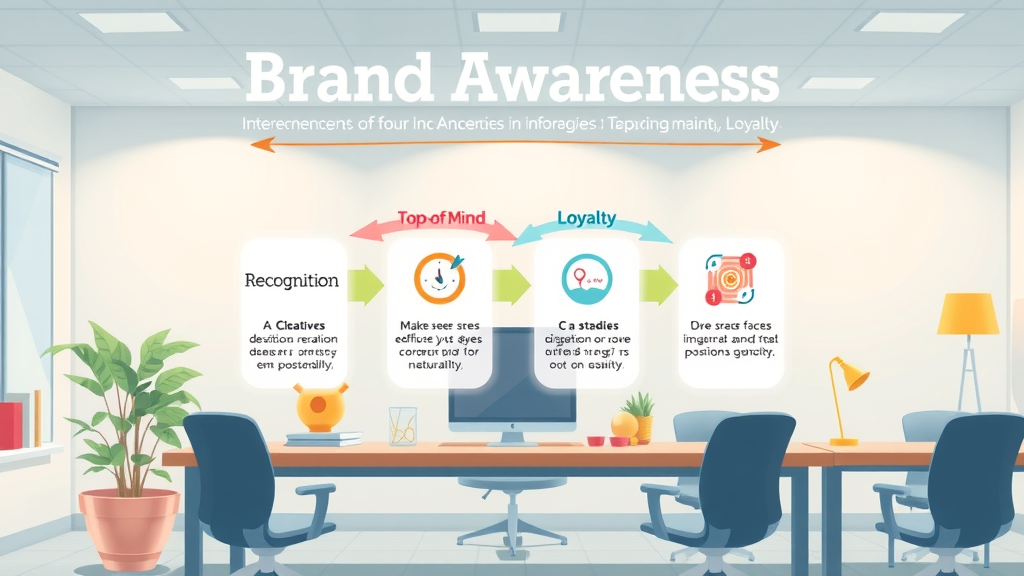Did you know that 80% of consumer choices are directly determined by brand awareness? Focusing solely on flashy marketing campaigns or product features—without first prioritizing brand awareness—can be a costly mistake that stunts your business growth. In this comprehensive guide, you’ll learn why strong brand awareness is the backbone of successful marketing and how to harness the power of recognition, recall, and trust to build a brand that thrives in any market.
- Why brand awareness is crucial to consumer choice
- The different types and stages of brand awareness
- Actionable strategies to increase brand visibility and strength
- How to measure brand awareness for real results
- Avoiding common pitfalls that undermine campaigns
- Case studies from brands that have built iconic awareness
Did You Know? Brand Awareness Directly Drives 80% of Consumer Choices
The importance of brand awareness can’t be overstated. Studies demonstrate that up to 80% of consumers are more likely to pick a product or service they recognize—even when similar options exist. Customers are bombarded daily with choices, and it's your brand’s visibility and familiarity that influence their purchasing decision most. Companies with high levels of brand awareness consistently outperform their competitors, gaining loyalty and increasing organic growth. This means that if you’re ignoring brand awareness in your strategy, you’re missing out on one of the most critical drivers of business success.
A significant part of this success comes from brand recall and brand recognition , two pillars that help consumers remember your brand, trust your expertise, and return as repeat buyers. Whether launching a new product or scaling your business, building brand awareness will set you apart and ensure that when consumers are ready to buy, your brand is top of mind. In the following sections, we’ll uncover the science and tools proven to help you create, measure, and maintain strong brand awareness.

Unlocking the True Value of Brand Awareness for Lasting Success
Emphasizing brand awareness provides more than just short-term gains—it delivers lasting, sustainable growth. When consumers are familiar with your brand or product , they’re more likely to engage, refer others, and choose your offerings repeatedly. This recognition lays the groundwork for developing a strong brand presence that commands customer loyalty and defends market share against emerging competitors. In highly competitive sectors, brands that prioritize awareness can turn customers into ardent advocates and maintain relevance even as trends evolve.
Thought leaders in marketing understand that the most powerful, enduring brands are those whose messages resonate at every level of brand interaction. By making your brand easily identifiable and relatable, you amplify word-of-mouth influence and establish a distinct position in consumers’ minds. Let’s explore what brand awareness truly means and why it should be at the heart of every effective marketing strategy.
Defining Brand Awareness: What Every Marketer Must Know
Brand awareness is the extent to which consumers are familiar with the distinctive qualities, visuals, and messaging of a specific brand. It’s the critical first step in the buyer’s journey—without awareness, customers can’t consider your products or services. Strong brand awareness allows you to connect emotionally, differentiate from competitors, and create loyalty that lasts beyond the initial sale. From small businesses to global giants, the brands that dominate their markets all started by building brand awareness as a core marketing pillar.
To build brand awareness effectively, marketers must go beyond logo placement or ad impressions. Instead, the focus should be on creating memorable brand touchpoints—everywhere your audience interacts with your brand, from your website to social media, packaging, and customer service. This holistic approach, grounded in research and best practices, lays the foundation for meaningful connections that drive business growth.
What Do You Mean by Brand Awareness?
Brand awareness is the degree to which consumers are able to recognize or recall your brand under different conditions. It’s not just knowing a logo or a name—it’s about evoking a specific feeling, association, or expectation whenever your brand is encountered. If your potential customers can name your brand without prompts, associate it with quality or expertise, or spot your logo in a crowded field, you have achieved a high level of brand awareness.
In today’s saturated market, brand awareness is a key determinant of campaign effectiveness. Brands with strong awareness are more likely to dominate a category, influence the purchasing decision, and command premium pricing. Think of household names whose colors, taglines, or mascots instantly trigger memories and emotions—that’s the real power of brand awareness in action.

Understanding Brand Recognition and Brand Recall
Brand recognition refers to a consumer’s ability to accurately identify your brand from visual cues such as logos, colors, or slogans. This is often the first step toward building brand equity, as recognition helps your brand stand out in a competitive landscape. However, recognition is only part of the puzzle: brand recall measures the consumer’s ability to remember your brand’s name or products without visual prompts. This spontaneous recollection is a direct result of effective campaigns, consistent messaging, and engaging content marketing.
Both recognition and recall are critical for effective marketing strategies. Brand recognition comes first, helping consumers pick you out of a crowd, while brand recall ensures that your brand emerges when buyers are making decisions—often ahead of competitors. Consistently reinforcing both factors is key to building brand awareness that lasts.
The Connection Between Brand Awareness and Brand Equity
Brand awareness lays the groundwork for brand equity —the value a brand adds to a product or service. The greater the awareness, the stronger the equity, as trusted brands command higher loyalty, market share, and price premiums. Brands with high equity can weather market disruptions, introduce new products more successfully, and retain customers through trust and positive associations.
In strong brand awareness campaigns, every customer interaction reinforces positive brand perceptions, further elevating brand equity over time. The benefits of this relationship go beyond monetary value; they foster credibility and advocate networks, granting your business a voice and influence far beyond advertising spend.
- Increases brand recall and recognition
- Builds long-lasting customer loyalty
- Fuels organic growth and engagement
- Strengthens brand equity and reputation
The 4 Stages of Brand Awareness: How to Build Brand Success
Understanding how to build brand awareness starts with a clear knowledge of its development stages. Each stage measures your audience’s journey from simply noticing your brand to relying on it as their default choice. By targeting your marketing strategies to address each stage, you’ll progress consumers from passive recognition to active loyalty, maximizing the impact of your campaigns.
What Are the Four Stages of Brand Awareness?
The four stages of brand awareness are: brand recognition , brand recall , top-of-mind awareness , and brand loyalty . Each stage marks a deepening connection with your brand, requiring tailored tactics and consistent effort from your team.
| Stage | Description |
|---|---|
| Brand Recognition | Audience identifies your brand |
| Brand Recall | Audience remembers your brand unprompted |
| Top-of-Mind Awareness | First brand that comes to mind |
| Brand Loyalty | Audience consistently chooses your brand |

Types of Brand Awareness: A Deep Dive
Not all brand awareness is created equal. Marketers should familiarize themselves with the main types— aided brand awareness and unaided brand awareness —to better design campaigns and evaluate results. Mastering each type ensures that your strategy addresses both general familiarity and deep, unaided loyalty.
What Are the Three Types of Brand Awareness?
Brand awareness is generally divided into three primary types:
- Aided Brand Awareness
- Unaided Brand Awareness
- Top-of-Mind Awareness
Aided brand awareness occurs when consumers recognize your name or logo after being prompted. Unaided brand awareness is stronger, indicating they recall your brand without any hints or suggestions. The gold standard— top-of-mind awareness —reflects that your brand is the first one remembered in a category, giving you a massive edge over competitors.
Mind Awareness and Its Strategic Importance
Mind awareness focuses on how quickly and spontaneously a brand surfaces in consumers’ minds, especially in buying situations. Brands that achieve top-of-mind awareness are able to dominate in their industries, as consumers reach for them instinctively, often ignoring other options. Mind awareness results from repeated exposure, consistent messaging, and powerful emotional branding that resonates deeply with your target audience.
Strategies to Create and Increase Brand Awareness
Successfully increasing brand awareness requires a comprehensive mix of creative, data-driven tactics. This includes deploying targeted social media campaigns, investing in content marketing, and designing engaging customer experiences. Today’s leading companies consistently rank increase brand awareness as a top marketing priority.
How Do I Create Brand Awareness?
To build brand awareness , start by defining a unique value proposition and developing a robust understanding of your target audience . Craft clear messaging that speaks directly to their needs and values. Leverage social media channels—where your audience spends time—to showcase stories, share behind-the-scenes content, and encourage engagement.
Thought leaders advise that the creative use of content marketing —including informative blog posts, eye-catching videos, and educational infographics—can help build a consistent presence. Use multi-channel campaigns to reinforce your message and maximize active brand touchpoints, ensuring your brand stands out at every customer interaction.

Step-by-Step Guide to Build Brand Awareness Effectively
- Define your audience and unique value proposition
- Use social media strategically
- Leverage content marketing and storytelling
- Launch creative marketing campaigns
- Engage through customer experiences
Each of these steps is crucial for building brand awareness . Identify precisely who you want to reach and why your brand matters to them. Develop a distinct voice and visual identity. Use social media tools to connect with users, respond in real-time, and expand your reach. Creative marketing campaigns and powerful storytelling not only inform but also inspire sharing—an organic way to increase brand awareness . Memorable customer experiences turn one-time buyers into loyal advocates, each championing your brand in new circles.
Using Social Media to Boost Brand Recognition
Social media platforms offer an unparalleled opportunity to increase brand awareness . By posting consistently, interacting with your audience, and creating shareable content, you can turn passive followers into active brand supporters. Social media channels serve as the front lines for both brand recognition and brand recall because they deliver your message directly to where your customers are most engaged.
Smart marketers also harness influencers, live streams, and interactive features like polls to humanize their brands, foster community, and collect valuable feedback. Adapting and monitoring your social media strategy ensures your brand always remains relevant, relatable, and recognizable amid evolving trends.

Content Marketing: Building Brand Awareness through Value-Driven Content
Effective content marketing is about delivering real value to your audience while weaving in your brand’s distinct personality and mission. Content can take many forms—educational articles, expert guides, tutorials, podcasts, or even user-generated content—and helps build authority and trust much faster than overt advertising. The key is to consistently produce and share high-quality material that addresses your audience’s needs and aspirations.
By solving problems, telling authentic stories, or sharing insights from thought leaders, content marketing positions your brand as an industry authority and go-to resource. This, in turn, supercharges your brand recognition and recall, moving interested prospects further along their decision-making process.
Marketing Campaigns That Drive Strong Brand Awareness
Creative marketing campaigns are crucial for capturing attention and sustaining strong brand awareness . Go beyond traditional channels by running interactive contests, launching branded hashtags, or hosting community events. Each campaign should be aligned with your overall message and focus on fostering positive emotional connections.
Monitor campaign results closely to determine what resonates best with your audience and adjust your efforts accordingly. Consistent innovation, paired with data-driven optimizations, ensures your campaigns achieve their maximum impact—helping build a thriving, recognizable brand.
"Brand awareness is not built overnight but is the foundation of strong brand equity. Brands that invest in awareness grow faster and survive longer." – Branding Expert
Metrics that Matter: How to Measure Brand Awareness
Any robust awareness campaign must be accompanied by clear, actionable measurement strategies. Understanding how to measure brand awareness ensures that your marketing resources are allocated efficiently and that you’re building genuine, long-term value for your business. Without reliable awareness metrics , even exceptional campaigns can falter, lacking the strategic guidance necessary for improvement.
Essential Brand Awareness Metrics for Marketers
- Reach and impressions
- Social engagement
- Direct and branded search traffic
- Surveys for brand recall and recognition
- Share of voice in digital channels
Reach and impressions provide a high-level overview of how many people encounter your brand. Social engagement —likes, shares, comments—reflects active interaction. Direct and branded search traffic show how many users seek out your brand specifically, a strong indicator of awareness. Surveys assessing brand recall and recognition offer valuable, actionable insights, while share of voice measures your visibility relative to competitors.
Tools and Techniques to Measure Brand Awareness
Use analytics suites like Google Analytics, SEMrush, and social media platforms to digest reach, engagement, and brand traffic data. Pair these figures with direct feedback from customer surveys to gauge unaided and aided brand awareness . Sophisticated tools can segment your audience, compare industry benchmarks, and identify strengths or weaknesses in your campaigns.
Tracking metrics consistently lets you refine your approach and zero in on the tactics that yield the highest impact, helping you allocate budgets for future growth and outperform your competition.

Brand Equity and Image: The Role of Strong Brand Awareness
A distinct, reputable brand image , built on the foundation of awareness, is what sets market leaders apart from everyone else. Brand equity builds over time as awareness, recognition, and trust increase. Strong awareness protects you from competitors, boosts customer lifetime value, and opens doors to premium pricing.
How Brand Awareness Fuels Brand Equity
Increasing brand awareness directly increases brand equity . Each time customers recall and choose your brand, the perceived value of your offering grows. Over time, the relationship between awareness and equity becomes a virtuous cycle: awareness drives value, which further enhances recall and recognition, deepening the customer relationship.
Brands like Nike and Apple have mastered this cycle, using awareness to foster intense loyalty and advocacy from customers. By prioritizing both visible and emotional connections, you can achieve similar results for your own business.
Enhancing Brand Image for Lasting Recognition
Brand image is the sum total of perceptions and feelings that customers associate with your business. Cultivating a strong, distinctive image requires consistent messaging, high-quality customer experiences, and dynamic use of visual branding elements. Every advertisement, customer service interaction, or social media post should reinforce the attributes you want the market to remember.
Focus on delivering on your promises and monitoring public feedback to identify areas for improvement. By intentionally shaping your brand image, you dramatically improve long-term recognition and loyalty.

Major Mistakes to Avoid in Your Brand Awareness Campaigns
Building brand awareness is not without its challenges—many campaigns fail due to avoidable mistakes. Being aware of these common pitfalls can save your business thousands in wasted spend and lost opportunities. The most frequent errors stem from neglecting the target audience , inconsistent messaging, and overlooking key performance indicators.
Why Ignoring Target Audience Insights Can Cripple Brand Awareness
Every strong brand campaign should begin with a detailed understanding of the target market. Ignoring or misinterpreting the interests, preferences, and pain points of your potential customers leads to wasted marketing strategies and poor results. Effective content marketing starts with clear persona research, segmentation, and testing.
Brands that fail to incorporate these insights risk being generic, irrelevant, or even off-putting, preventing the development of true awareness.
Pitfalls of Inconsistent Messaging in Building Brand Awareness
Consistency is essential when building brand awareness . Changing your logo, tone, visual style, or value proposition too often can confuse your audience, undermining trust and recall. Cohesive messaging creates clear expectations and a unified brand identity, turning each touchpoint into a reinforcement instead of a contradiction.
Inconsistency erodes whatever progress you’ve built and can cost you dearly in terms of lost engagement or negative public perceptions.
Overlooking Awareness Metrics Undermines Long-Term Growth
Without monitoring the right awareness metrics , you risk letting your campaigns stagnate—failing to capitalize on successes or adjust to shortcomings. Many businesses launch marketing campaigns but never revisit performance data, missing valuable insights for future improvements. Continual tracking ensures your efforts remain aligned with business objectives and maximizes your ROI.
- Neglecting consistent brand voice
- Failing to track and adapt awareness metrics
- Missing out on social media brand touchpoints
- Relying on one type of marketing campaign

Case Studies: Brands That Excelled at Building Brand Awareness
Some of the world’s most valuable brands show exactly how brand awareness can be engineered and maintained for sustained growth. Learn from these examples to inform your next big campaign.
How Nike Increased Brand Recall through Social Media Campaigns
Nike is a masterclass in leveraging social media to boost brand recall and recognition. With authentic influencer collaborations, inspirational hashtag challenges, and viral video content, Nike creates campaigns that transcend mere advertising. Their consistent use of visual branding, motivational messaging, and active audience engagement drives home top-of-mind awareness—and generates global conversation.

Apple’s Journey: From Brand Recognition to Top-of-Mind Awareness
Apple has transformed brand recognition into powerful top-of-mind awareness through uniform design, minimalist campaigns, and a cult-like focus on product quality. Their storytelling and community-driven events make each product launch a global event, engaging both media and fiercely loyal customers. Apple’s marketing strategy proves that investing in brand awareness pays perpetual dividends.
Through both subtle consistency and occasional boldness, Apple ensures its brand remains the first thought when customers consider innovation, design, or premium technology solutions.
Lessons from Local Businesses in Building Brand Awareness
You don’t have to be a giant to build brand awareness . Local businesses succeed by sponsoring community events, telling stories through user testimonials, and cultivating authentic relationships at the ground level. By focusing on relevance, frequent engagement, and delivering on their promises, these businesses create deep-seated loyalty and personal recommendations that are worth more than any paid ad campaign.
Smaller brands can excel by harnessing local influencers and staying visible in the digital spaces their audiences frequent, proving awareness can start anywhere and scale everywhere.
Practical Tips to Increase Brand Awareness Effectively
- Invest in innovative marketing campaigns
- Harness influencers for wider reach
- Foster brand storytelling
- Create interactive customer experiences

Strong Brand Awareness Begins with Consistent Value Delivery
The secret to strong brand awareness lies in consistently providing value at every stage of your customer journey. From your content and community engagement to your sales and support, customers should always know what your brand stands for and how it improves their lives.
Under-promise, over-deliver, and maintain the highest standards in your products or services. This commitment builds a formidable reputation and an organic growth engine fueled by loyal advocates.
"Consumers don’t just buy products; they buy into brands they know and trust. Awareness is the bridge to loyalty."
Frequently Asked Questions about Brand Awareness
What do you mean by brand awareness?
Brand awareness refers to how familiar your target audience is with your brand and how easily they recognize it among competitors. It involves name recognition, logo visibility, and consumers’ ability to recall and trust your business when faced with options in your niche.
What are the 4 stages of brand awareness?
The four stages are brand recognition , brand recall , top-of-mind awareness , and brand loyalty . Progressing through these stages means your brand moves from being noticed to being the preferred or default choice for consumers in your category.
What are the three types of brand awareness?
The three main types are aided brand awareness (recognition after prompting), unaided brand awareness (recalled without prompts), and top-of-mind awareness (the first brand considered). Each represents a deeper level of audience connection and market influence.
How do I create brand awareness?
Start by defining your target audience and crafting compelling messages that highlight your unique value. Use social media, influencers, and content marketing to expand your reach. Launch multi-channel campaigns and consistently engage customers, tracking your results and refining your strategies for continuous growth.
- Prioritize consistent messaging and recognition
- Track impact via relevant metrics
- Continuously innovate in social media and content marketing
- Avoid costly campaign mistakes by planning and measuring success
Ready to Build Unstoppable Brand Awareness?
Call us at (385) 469-1869 or email at info@solu4u.com today to drive your brand awareness campaigns to the next level!
Take action now: Prioritize brand awareness, consistently track your efforts, and commit to continuous value delivery for unmatched brand growth and customer loyalty.
Sources
- https://www.hubspot.com/marketing-statistics
- https://www.wordstream.com/brand-awareness
- https://www.oberlo.com/blog/brand-awareness
- https://www.surveymonkey.com/curiosity/brand-awareness
- https://sproutsocial.com/insights/brand-awareness/
To deepen your understanding of brand awareness and its pivotal role in consumer decision-making, consider exploring the following resources:
- “What Is Brand Awareness? Definition, Importance & Strategies” ( agilityads.com )
This article provides a comprehensive overview of brand awareness, detailing its significance and offering strategic approaches to enhance it.
- “Brand Awareness: What It Is and How to Improve It” ( adobe.com )
This resource delves into the concept of brand awareness, explaining its importance and providing actionable strategies for improvement.
By engaging with these materials, you’ll gain valuable insights into building and measuring brand awareness, equipping you with the tools to strengthen your brand’s presence in the market.
 Add Row
Add Row  Add
Add 




Write A Comment